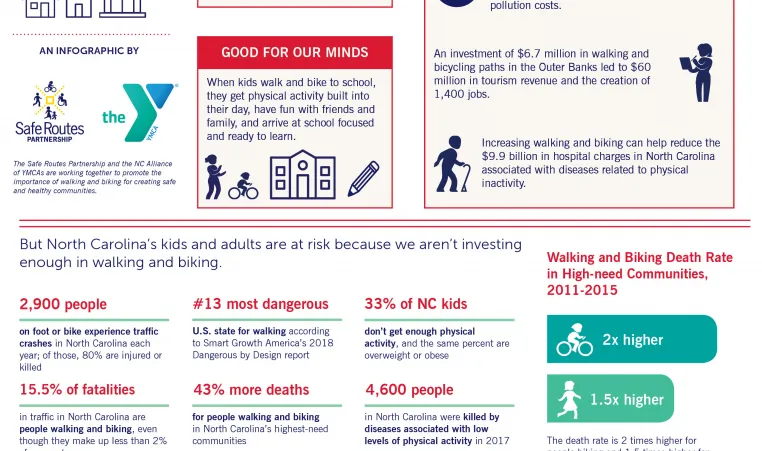
What does the landscape look like in North Carolina for safe walking and biking? There’s plenty of work to be done. This new infographic, created by the NC Alliance of YMCAs in collaboration with the Safe Routes Partnership, highlights the need across our state.
Two-thirds of North Carolinians feel unsafe walking along a road without sidewalks, according to an Elon University poll released in June 2019. Only half of those polled feel safe walking on a sidewalk next to a road. (See “How Safe Are Our Streets for Pedestrians in Car-Centric North Carolina?” June 6, 2019, News & Observer).
According UNC Highway Safety Research Center and the NC Division of Motor Vehicles, 197 pedestrians were killed in motor vehicle crashes in 2017 in North Carolina, and another 2,596 were injured. The death rate by bike is 2 times as high in Tier 1 (high need/least thriving) communities and 1.5 times higher in high-need communities for walking.
Safe streets are also fundamentally important for healthier communities. More than one-third of children in North Carolina don’t get enough of the recommended physical activity each day and are also overweight or obese. Nearly $10 million in hospital charges were associated with diseases related to physical inactivity in 2017 in North Carolina.
Advocacy and Partnerships
The NC Alliance of YMCAs continues its public policy work to create healthier communities across the state through increased pedestrian and bicycle infrastructure. Currently, in North Carolina, most communities are unable to allocate funding to such projects. While the federal government provides Transportation Alternatives Program (TAP) funding each year, it allows states to transfer up to half of their TAP to other projects.
As a result, states that transfer TAP funding are prioritizing roads and bridges above the safety of people walking and bicycling. Because North Carolina requires a 20% local match to the federal funding, low-wealth communities are largely unable to find the dollars for walk/bike projects.
This year, the NC Alliance has focused on improving bike/ped infrastructure with the support of YUSA grant funding via the Centers for Disease Control and Prevention (CDC). The grant includes an emphasis on working state partners to advance at least one of the four core areas in the Safe Routes Partnership’s State Report Card for North Carolina.
Through the grant, the Alliance has also partnered with AARP North Carolina to fund the purchase of tactical urbanism (TU) project equipment. TU projects such as pop-up bike lanes, parklets and pedestrian plazas provide opportunities for community activism designed to support long-term infrastructure changes. In August, the YMCA of Western North Carolina will partner with AARP on a TU project in Ashville, and the YMCA of Southeastern North Carolina will partner with AARP on a project in Southport.
(Photo by Justin Mitchell; Coxe St., Asheville, NC, tactical urbanisim project completed in fall 2018)
Educate and Invest
YMCAs, partners and advocates across the state can educate lawmakers about the need for safer streets, particularly in our higher-need, smaller communities. It’s time for North Carolina to invest in infrastructure for safe walkable and bikeable communities.